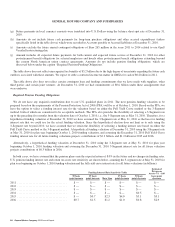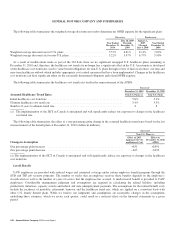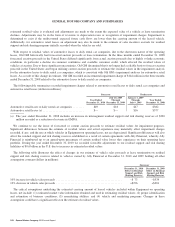General Motors 2010 Annual Report Download - page 101
Download and view the complete annual report
Please find page 101 of the 2010 General Motors annual report below. You can navigate through the pages in the report by either clicking on the pages listed below, or by using the keyword search tool below to find specific information within the annual report.GENERAL MOTORS COMPANY AND SUBSIDIARIES
assets is based on the fair value of the underlying assets owned by these accounts. The separately managed investment
accounts, which typically calculate NAV, and underlying assets are valued in accordance with the valuation policies of the
respective insurers. Inherent restrictions that do not allow redemption of our entire investment at NAV at the measurement
date or in the near-term are the primary considerations for these investments being classified in Level 3.
• Agency and non-agency mortgage and other asset-backed securities — Pricing services and dealers often use proprietary
pricing models which incorporate unobservable inputs. These inputs typically consist of prepayment curves, discount rates,
default assumptions and recovery rates. Management may consider other security attributes such as liquidity, market activity,
price level, credit ratings and geo-political risk, in assessing the observability of inputs used by pricing services or dealers,
which may affect classification in the fair value hierarchy.
• Investment funds, private equity and debt investments, and real estate assets — The funds and certain special purpose entities
valued using NAV, and in which we may not have the ability to redeem our entire investment with the investee at NAV at the
measurement date or in near-term, are classified in Level 3. The Level 3 inputs for these investments include NAV provided
by the investment sponsor or third party administrator. When NAV was not used as a practical expedient, the fair value
estimates provided by investment sponsors are used. These fair value estimates are reviewed, and in cases where these
estimates do not represent fair value they may be adjusted by management based on changes in the composition or
performance of the underlying investments or comparable investments, overall market conditions, and other economic factors.
Such fair value adjustments at December 31, 2009 and 2010 were not significant.
Refer to Note 4 to our consolidated financial statements for a more detailed discussion of the inputs used to determine fair value for
each significant asset class or category.
Other Postretirement Benefits
OPEB plans are accounted for on an actuarial basis, which requires the selection of various assumptions, including a discount rate
and healthcare cost trend rates. Old GM estimated the discount rate using an iterative process based on a hypothetical investment in a
portfolio of high-quality bonds rated AA or higher by a recognized rating agency and a hypothetical reinvestment of the proceeds of
such bonds upon maturity using forward rates derived from a yield curve until the U.S. OPEB obligation was defeased. This
reinvestment component was incorporated into the methodology because it was not feasible, in light of the magnitude and time
horizon over which the U.S. OPEB obligations extend, to accomplish full defeasance through direct cash flows from an actual set of
bonds selected at any given measurement date.
Beginning in September 2008, the discount rate used for the benefits to be paid from the UAW retiree medical plan during the
period September 2008 through December 2009 was based on a yield curve which used projected cash flows of representative high-
quality AA rated bonds matched to spot rates along a yield curve to determine the present value of cash flows to calculate a single
equivalent discount rate. All other U.S. OPEB plans started using a discount rate based on a yield curve on July 10, 2009. The UAW
retiree medical plan was settled on December 31, 2009 and the plan assets were contributed to the New VEBA as part of the payment
terms under the 2009 UAW Retiree Settlement Agreement. We are released from UAW retiree healthcare claims incurred after
December 31, 2009.
The significant non-U.S. OPEB plans cover Canadian employees. The discount rates for the Canadian plans are determined using a
cash flow matching approach, similar to the U.S. OPEB plans.
General Motors Company 2010 Annual Report 99
























